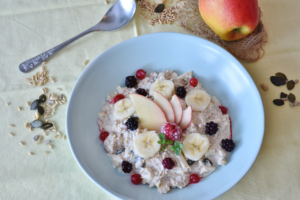The Provitamin A Carotenoids and Osteoporosis

The latest research appears to indicate some concerns for high doses of vitamin A increasing the risks for osteoporosis and bone fractures. What’s interesting is that vitamin A from plant sources, called provitamin A, doesn’t appear to carry the same risks.
Vitamin A comes in two forms. The first is called retinol, found in animal products like meat, eggs, seafood and dairy. The second form is called provitamin A, a precursor to vitamin A found in plants. Provitamin A includes several carotenoids: alpha-carotene, beta-carotene and beta-cryptoxanthin. In plants, carotenoids are red, yellow and orange colored compounds that often give fruits and vegetables their vibrant colors.
It’s worth noting that not all carotenoids are precursors for vitamin A. Lutein and lycopene are carotenoids that are similar structurally, but cannot be converted into vitamin A by the human body.
General Health Benefits of Carotenoids
Typically, recommendations for a healthy diet include eating plenty of fruits and vegetables. Higher consumption of fruits and vegetables will increase consumption of carotenoids. Interestingly, diets high in carotenoids have been shown to decrease risks of heart disease and cancer (Kritchevsky 1999. Tanaka 2012). However, studies giving isolated, synthetic beta-carotene have found no benefit. In heavy smokers, synthetic beta-carotene combined with vitamin A even increased the risks for lung cancer and death (Omenn 1996).
Synthetic Beta-Carotene
Risks of increased lung cancer from synthetic beta-carotene may be related to chemical differences between synthetic beta-carotene and the natural form. In nature, beta-carotene is found in two forms: all-trans and 9-cis. The synthetic version is different, including only the all-trans form.
All-trans beta-carotene is primarily turned into vitamin A and doesn’t have as strong of antioxidant benefits. Whereas, 9-cis beta-carotene appears to have more antioxidant potential (Ben-Amotz 1996, Levin 1994). These differences may explain the problems associated with synthetic beta-carotene, although other theories have also been advanced. Obviously, more research is required to know for sure.
Effects of Carotenoids on Bone
In a Japanese study of postmenopausal women, higher levels of beta-carotene and beta-cryptoxanthin were both associated with lower incidence of osteopenia and osteoporosis. In fact, the highest blood levels of beta-carotene were associated with a 76% reduction in risk. For beta-cryptoxanthin, protection appeared even more robust, reaching 93% (Sugiura 2012). While correlations with all bone density sites was not always significant, other studies have also found serum levels of carotenoids to correlate with improved bone density (Sahni 2009, Sugiura 2007).
Beta-Carotene
While there are some mixed results, a recent meta-analysis of beta-carotene consumption and fracture did find benefits. Higher dietary beta-carotene intake decreased fracture risk by 33% (Charkos 2020). The authors recommended randomized controlled trials to confirm the effects.
Beta-cryptoxanthin
A review from 2012 outlines the research on beta-cryptoxanthin and bone health. Studies have consistently found that beta-cryptoxanthin stimulates bone formation while inhibiting bone breakdown. Studies in postmenopausal women, premenopausal women and men have all appeared to confirm the beneficial effects of beta-cryptoxanthin on bone health (Yamaguchi 2012).
Alpha-Carotene
While the evidence for alpha-carotene is less robust, it still appears that it may support bone health. A study out of China showed that women with higher levels of alpha-carotene had higher bone mineral density. In men, alpha-carotene was the only carotenoid tested that appeared to correlate with better bone density (Zhang 2016). While not all studies found benefits with alpha-carotene, often total carotenoids, which includes alpha-carotene, still correlate with improved bone health and reduced fracture risk (Xu 2017).
So Why Does Vitamin A Have a Negative Effect on Bone Health, but Provitamin A Does Not?
While there are concerns for high vitamin A consumption and osteoporosis, provitamin A from carotenoids appear to have beneficial effects. Since provitamin A can be converted into vitamin A, this may at first glance seem paradoxical. However, conversion rates of provitamin A into vitamin A are highly variable and often fairly low (Tang 2010). It’s likely the benefits from carotenoids are derived from the carotenoids themselves without causing major increases in circulating vitamin A levels.

Food Sources
Foods rich in provitamin A include: carrots, sweet potatoes, bell peppers, leafy vegetables, cantaloupe, tomatoes, apricots, broccoli, pumpkin and citrus fruit (Arscott 2012). Most other plants with yellow, orange and red coloration contain carotenoids as well.
Summary
Provitamin A carotenoids appear to have benefits for bone health. Diets high in carotenoids are typically correlated with lower rates of osteoporosis. In some cases, direct trials of certain carotenoids have also shown benefits for inhibiting bone breakdown. Including plenty of fruits and vegetables rich in carotenoids can likely play a part in a healthy dietary strategy to prevent bone loss. As a side note, supplementing with synthetic beta-carotene is not recommended.



